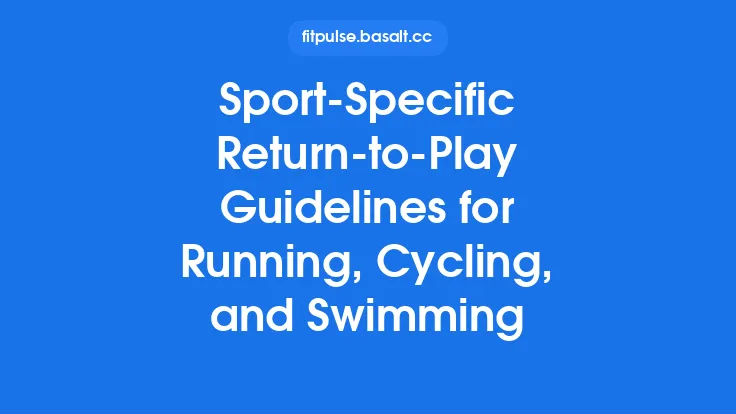Returning to sport after an injury is a delicate balance between rebuilding capacity and avoiding a setback. While many athletes focus on the “when” and “if” of returning, the “how” often determines long‑term success. Progressive load management provides a systematic, data‑driven blueprint that guides athletes from the first tolerated activity back to full competition intensity. By incrementally increasing mechanical and metabolic demands, this approach respects tissue healing timelines, optimizes neuromuscular adaptations, and minimizes the risk of re‑injury. Below is a comprehensive guide to implementing progressive load management as a cornerstone of safe return‑to‑play (RTP) planning.
Understanding Load in Athletic Performance
External vs. Internal Load
- External load refers to the objective work performed, such as distance covered, number of repetitions, weight lifted, or impact forces measured by GPS, accelerometers, or force plates.
- Internal load captures the athlete’s physiological and perceptual response to that work, commonly expressed through heart‑rate zones, blood lactate, session Rating of Perceived Exertion (sRPE), or hormonal markers.
Both dimensions are essential. External load tells you what was done; internal load tells you how the athlete tolerated it. Discrepancies between the two (e.g., high external load but low internal strain) can signal good adaptation, whereas a spike in internal load with modest external work may indicate fatigue or lingering pathology.
Acute‑Chronic Workload Ratio (ACWR)
A widely used metric, the ACWR compares the load of the most recent week (acute) to the average load of the preceding 3–4 weeks (chronic). Ratios between 0.8 and 1.3 are generally considered “sweet spots,” whereas values >1.5 have been linked to heightened injury risk. While ACWR is not a stand‑alone decision tool, it offers a quick snapshot of load spikes that merit closer inspection.
Progressive Overload Principle
The cornerstone of any training adaptation, progressive overload dictates that a stimulus must be incrementally increased to elicit further physiological change. In the RTP context, this principle is applied conservatively, ensuring that each load increase is supported by tissue healing and functional capacity.
Core Principles of Progressive Load Management
- Individualization – Baseline load tolerance varies with injury type, surgical repair, age, training history, and genetics. A one‑size‑fits‑all progression is inappropriate; each athlete’s plan should start from their current functional baseline.
- Gradualism – Load increments should be modest (typically 5‑10 % per week) and contingent on the athlete’s response. Sudden jumps in volume, intensity, or frequency are the most common precursors to re‑injury.
- Specificity – The load progression must reflect the mechanical demands of the sport. For a sprinter, emphasis on high‑velocity, low‑duration loads is critical; for a weightlifter, progressive increases in load magnitude and bar speed are paramount.
- Periodization Integration – Load management should dovetail with macro‑, meso‑, and micro‑cycle planning. Early RTP phases align with “pre‑competition” or “re‑conditioning” blocks, gradually shifting toward “competition‑specific” loads.
- Feedback Loops – Continuous monitoring of both external and internal load, combined with regular clinical checks, creates a feedback loop that informs load adjustments in real time.
Designing a Load Progression Framework
1. Baseline Assessment
- Establish the athlete’s current external load capacity (e.g., maximal tolerated distance, load, or repetitions).
- Record internal load responses (sRPE, heart‑rate variability, perceived soreness).
- Use these data points to set the starting point of the progression.
2. Define Load Variables
- Volume (total distance, total repetitions, total sets).
- Intensity (percentage of 1RM, speed zones, heart‑rate zones).
- Frequency (sessions per week).
- Complexity (movement patterns, sport‑specific drills).
3. Set Incremental Targets
- Choose a primary variable to manipulate each week (e.g., volume).
- Apply a 5‑10 % increase, ensuring the other variables remain stable to isolate the adaptation stimulus.
4. Incorporate “Recovery Sessions”
- Not all sessions are progressive; low‑intensity, technique‑focused days serve to consolidate adaptations while allowing tissue remodeling.
5. Establish “Load Checkpoints”
- At predetermined intervals (e.g., every 2 weeks), compare acute load to chronic load and review internal load markers.
- If the ACWR exceeds 1.5 or sRPE spikes >2 points above baseline, pause progression and reassess.
Quantifying and Tracking Load
| Metric | Tool | What It Captures | Typical Thresholds |
|---|---|---|---|
| Distance / Speed | GPS, accelerometer | External volume & intensity | Incremental 5‑10 % weekly |
| Repetitions / Sets | Training log | External volume | 5‑10 % weekly increase |
| Session RPE (sRPE) | 0‑10 scale | Internal load perception | ≤2‑point rise per week |
| Heart‑Rate Variability (HRV) | Wearable HR monitor | Autonomic recovery | <5 % drop from baseline warrants caution |
| Acute‑Chronic Workload Ratio | Spreadsheet / software | Load spike detection | 0.8‑1.3 optimal; >1.5 high risk |
| Impact Load (G‑force) | Force plate, wearable | Mechanical stress | Keep within 10‑15 % of pre‑injury baseline initially |
A simple spreadsheet can integrate these metrics, automatically calculating ACWR and flagging outliers. More sophisticated platforms (e.g., Catapult, Kitman Labs) provide dashboards that visualize trends for coaches, clinicians, and athletes alike.
Integrating Load Management into Training Cycles
Micro‑Cycle (Weekly) Example
| Day | Focus | External Load | Internal Load Target |
|---|---|---|---|
| Mon | Recovery/Technique | Low volume, <30 % of max distance | sRPE ≤3 |
| Tue | Strength (moderate) | 3 sets × 8 reps @ 60 % 1RM | HRV within 2 % of baseline |
| Wed | Aerobic Conditioning | 60 % of max distance | sRPE 4‑5 |
| Thu | Sport‑Specific Drills | 70 % of max intensity, low volume | HR <85 % max |
| Fri | Strength (progressive) | 4 sets × 6 reps @ 70 % 1RM | sRPE 5‑6 |
| Sat | Simulated Game Play | 80 % of competition load | ACWR ≤1.2 |
| Sun | Rest | — | — |
Mesocycle (4‑6 weeks) Progression
- Weeks 1‑2: Emphasize low‑to‑moderate intensity, high technique fidelity.
- Weeks 3‑4: Introduce moderate‑to‑high intensity with controlled volume.
- Weeks 5‑6: Transition to near‑competition loads, incorporating full‑speed, sport‑specific scenarios.
Macrocycle (Season‑Long) Alignment
- Early season: Use progressive load management as a “re‑conditioning” block for athletes returning from injury.
- Mid‑season: Maintain load within the optimal ACWR window, adjusting for competition density.
- Late season: Taper load strategically while preserving the adaptations achieved during the RTP phase.
Adapting Load Based on Individual Response
Even with a well‑structured plan, athletes will respond differently. Key signals that warrant load modification include:
- Elevated sRPE (>2 points above the expected range for a given session).
- Persistent localized soreness beyond 48 hours.
- Deviations in HRV indicating autonomic imbalance.
- Altered movement mechanics observed during video analysis (e.g., compensatory gait patterns).
When any of these arise, the safest course is to reduce the primary load variable (often volume) by 10‑20 % and maintain other variables constant. Re‑evaluate after 48‑72 hours; if the response normalizes, resume the planned progression.
Technology and Tools for Load Management
- Wearable GPS/IMU Units – Provide real‑time distance, speed, acceleration, and impact data.
- Force Platforms – Quantify ground‑reaction forces, useful for monitoring load during jumps or sprints.
- Heart‑Rate Monitors & HRV Apps – Offer insight into cardiovascular strain and recovery status.
- Cloud‑Based Training Management Software – Centralize data from multiple sources, generate ACWR calculations, and flag outliers automatically.
- Mobile sRPE Apps – Allow athletes to log perceived exertion immediately post‑session, ensuring accurate internal load capture.
When selecting tools, prioritize reliability, ease of use, and integration capability with existing data pipelines. Over‑reliance on a single metric can be misleading; a multimodal approach yields the most robust picture.
Case Example: Applying Progressive Load Management
Athlete Profile
- 24‑year‑old male soccer midfielder
- Sustained a Grade II hamstring strain, cleared for light activity after 3 weeks of physiotherapy
Initial Baseline
- Max tolerated jogging distance: 2 km (sRPE 5)
- sRPE for a standard strength session: 6 (3 sets × 10 reps @ 60 % 1RM)
- HRV: 5 % below pre‑injury baseline
Progression Plan (6‑Week Overview)
| Week | Primary Load Variable | Increment | Monitoring Focus |
|---|---|---|---|
| 1 | Jog distance | +10 % (2.2 km) | sRPE ≤6, HRV within 2 % of baseline |
| 2 | Strength intensity | +5 % (65 % 1RM) | sRPE ≤6, no increase in hamstring soreness |
| 3 | Sprint volume (10 m repeats) | 4 × 30 m → 5 × 30 m | sRPE ≤5, ACWR ≤1.2 |
| 4 | Jog distance | +10 % (2.4 km) | HRV stable, no pain |
| 5 | Strength intensity | +5 % (70 % 1RM) | sRPE ≤6, maintain technique |
| 6 | Full‑field simulated play | 70 % of match load | ACWR 1.1, sRPE 7, HRV within 1 % of baseline |
Outcome
- Athlete completed a full match at 90 % of pre‑injury load by week 7 with no recurrence.
- Data showed a smooth ACWR trajectory (0.9 → 1.1) and stable internal load markers, confirming the efficacy of the progressive load framework.
Key Takeaways for Coaches and Practitioners
- Start with a data‑driven baseline – Quantify both what the athlete does and how they feel.
- Apply modest, systematic load increments – 5‑10 % per week is a practical rule of thumb.
- Monitor the acute‑chronic workload ratio – Keep it within the 0.8‑1.3 “sweet spot” to avoid spikes.
- Use a multimodal monitoring suite – Combine GPS/IMU data, heart‑rate/HRV, and sRPE for a holistic view.
- Integrate load progression into the broader periodization plan – Align RTP phases with the season’s macro‑cycle.
- Be ready to regress – If internal load signals (sRPE, HRV, soreness) deviate, reduce load before progressing.
- Leverage technology wisely – Choose reliable tools that feed into a central data platform for real‑time decision making.
By embedding progressive load management into the return‑to‑play process, practitioners can provide athletes with a clear, evidence‑based pathway back to competition—one that respects the biology of healing while fostering the performance gains needed for long‑term success.





